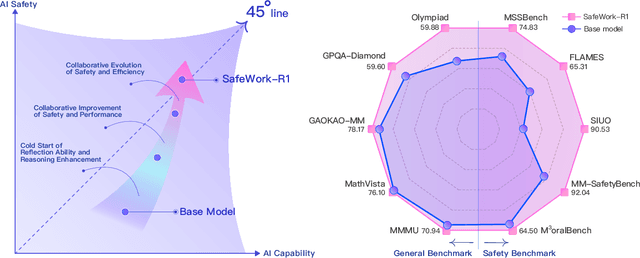Qingnan Ren
Echo: Decoupling Inference and Training for Large-Scale RL Alignment on Heterogeneous Swarms
Aug 07, 2025Abstract:Modern RL-based post-training for large language models (LLMs) co-locate trajectory sampling and policy optimisation on the same GPU cluster, forcing the system to switch between inference and training workloads. This serial context switching violates the single-program-multiple-data (SPMD) assumption underlying today's distributed training systems. We present Echo, the RL system that cleanly decouples these two phases across heterogeneous "inference" and "training" swarms while preserving statistical efficiency. Echo introduces two lightweight synchronization protocols: a sequential pull mode that refreshes sampler weights on every API call for minimal bias, and an asynchronous push-pull mode that streams version-tagged rollouts through a replay buffer to maximise hardware utilisation. Training three representative RL workloads with Qwen3-4B, Qwen2.5-7B and Qwen3-32B on a geographically distributed cluster, Echo matches a fully co-located Verl baseline in convergence speed and final reward while off-loading trajectory generation to commodity edge hardware. These promising results demonstrate that large-scale RL for LLMs could achieve datacentre-grade performance using decentralised, heterogeneous resources.
SafeWork-R1: Coevolving Safety and Intelligence under the AI-45$^{\circ}$ Law
Jul 24, 2025



Abstract:We introduce SafeWork-R1, a cutting-edge multimodal reasoning model that demonstrates the coevolution of capabilities and safety. It is developed by our proposed SafeLadder framework, which incorporates large-scale, progressive, safety-oriented reinforcement learning post-training, supported by a suite of multi-principled verifiers. Unlike previous alignment methods such as RLHF that simply learn human preferences, SafeLadder enables SafeWork-R1 to develop intrinsic safety reasoning and self-reflection abilities, giving rise to safety `aha' moments. Notably, SafeWork-R1 achieves an average improvement of $46.54\%$ over its base model Qwen2.5-VL-72B on safety-related benchmarks without compromising general capabilities, and delivers state-of-the-art safety performance compared to leading proprietary models such as GPT-4.1 and Claude Opus 4. To further bolster its reliability, we implement two distinct inference-time intervention methods and a deliberative search mechanism, enforcing step-level verification. Finally, we further develop SafeWork-R1-InternVL3-78B, SafeWork-R1-DeepSeek-70B, and SafeWork-R1-Qwen2.5VL-7B. All resulting models demonstrate that safety and capability can co-evolve synergistically, highlighting the generalizability of our framework in building robust, reliable, and trustworthy general-purpose AI.
Logic-RL: Unleashing LLM Reasoning with Rule-Based Reinforcement Learning
Feb 20, 2025



Abstract:Inspired by the success of DeepSeek-R1, we explore the potential of rule-based reinforcement learning (RL) in large reasoning models. To analyze reasoning dynamics, we use synthetic logic puzzles as training data due to their controllable complexity and straightforward answer verification. We make some key technical contributions that lead to effective and stable RL training: a system prompt that emphasizes the thinking and answering process, a stringent format reward function that penalizes outputs for taking shortcuts, and a straightforward training recipe that achieves stable convergence. Our 7B model develops advanced reasoning skills-such as reflection, verification, and summarization-that are absent from the logic corpus. Remarkably, after training on just 5K logic problems, it demonstrates generalization abilities to the challenging math benchmarks AIME and AMC.
 Add to Chrome
Add to Chrome Add to Firefox
Add to Firefox Add to Edge
Add to Edge